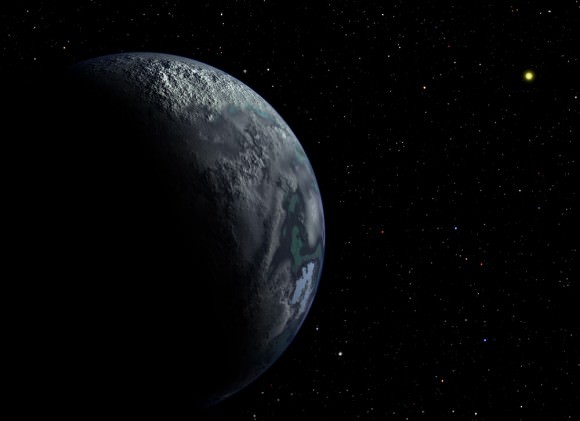
In this artist's conception, a captured world drifts at the outer edge of a distant star system, so far from its Sun-like host that the star's disk is barely resolvable at upper right. New research shows that one in 20 stars within our galaxy might have captured a free-floating planet. Credit: Christine Pulliam (CfA)
As crazy as it sounds, free-floating rogue planets have been predicted to exist for quite some time and just last year, in May 2011, several orphan worlds were finally detected. Then, earlier this year, astronomers estimated that there could be 100,000 times more rogue planets in the Milky Way than stars. Now, the latest research suggests that sometimes, these rogue, nomadic worlds can find a new home by being captured into orbit around other stars. Scientists say this finding could explain the existence of some planets that orbit surprisingly far from their stars, and even the existence of a double-planet system.
“Stars trade planets just like baseball teams trade players,” said Hagai Perets of the Harvard-Smithsonian Center for Astrophysics.
Astronomers now understand that rogue planets are a natural consequence of both star and planetary formation. Newborn star systems often contain multiple planets, and if two planets interact, one can be ejected in a form of planetary billiards, kicked out of the star system to become an interstellar traveler.
But later, if a rogue planet encounters a different star moving in the same direction at the same speed, be captured into orbit around that star, say Perets and Thijs Kouwenhoven of Peking University, China, the authors of a new paper in The Astrophysical Journal.
A captured planet tends to end up hundreds or thousands of times farther from its star than Earth is from the Sun. It’s also likely to have a, orbit that’s tilted relative to any native planets, and may even revolve around its star backward.
Perets and Kouwenhoven simulated young star clusters containing free-floating planets. They found that if the number of rogue planets equaled the number of stars, then 3 to 6 percent of the stars would grab a planet over time. The more massive a star, the more likely it is to snag a planet drifting by.
While there haven’t actually been planets found yet that are definitely a ‘captured’ world, the best bet would perhaps be a planet in a distant orbit around a low-mass star. The star’s disk wouldn’t contain enough material to form a planet that distant, Perets and Kouwenhoven said.
The best evidence of a captured planet comes from the European Southern Observatory, which announced in 2006 the discovery of two planets (weighing 14 and 7 times Jupiter) orbiting each other without a star.
“The rogue double-planet system is the closest thing we have to a ‘smoking gun’ right now,” said Perets. “To get more proof, we’ll have to build up statistics by studying a lot of planetary systems.”
As for our own solar system, there’s no evidence at this time that our Sun could have captured an alien world, which would lie far beyond Pluto.
“There’s no evidence that the Sun captured a planet,” said Perets. “We can rule out large planets. But there’s a non-zero chance that a small world might lurk on the fringes of our solar system.”
Source: Universe Today
No hay comentarios:
Publicar un comentario